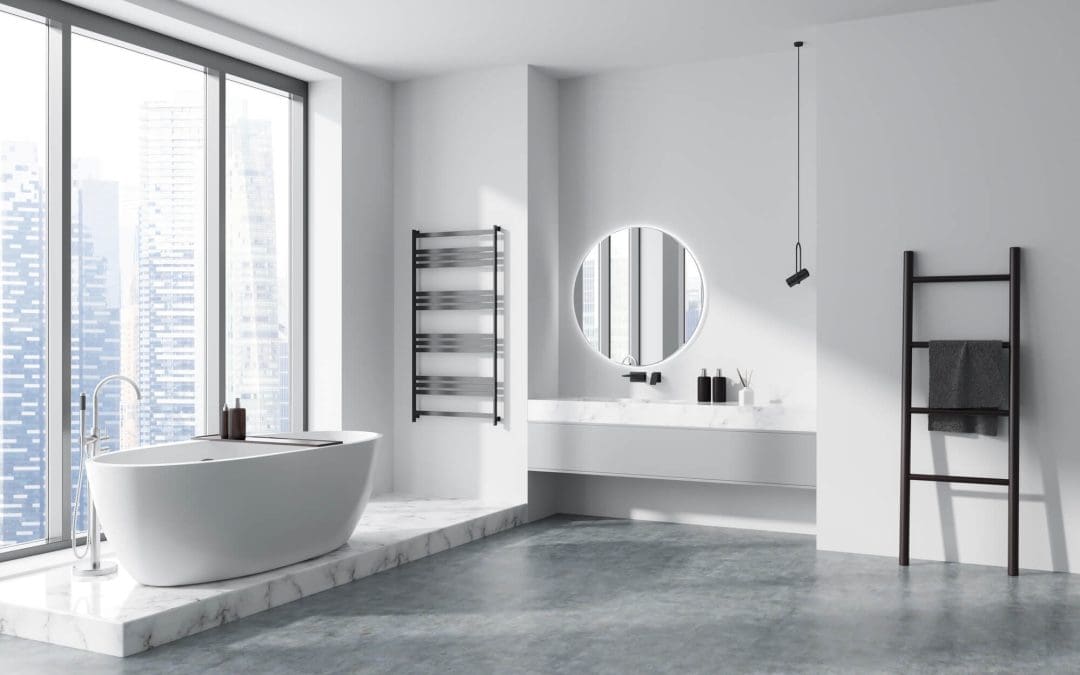Choosing the right flooring for your bathroom is a decision that goes beyond aesthetics. Bathrooms are unique spaces in your home where moisture, humidity, and temperature changes are constant factors. Selecting the appropriate material can make a significant difference in durability and style. In this guide, we’ll break down some of the most popular bathroom flooring options and their pros and cons so you can make an informed decision.
Ceramic and Porcelain Tile Bathroom Flooring
Ceramic and porcelain tiles are among the most common bathroom flooring choices, and for good reason. These materials are highly resistant to water and come in a wide range of colors, patterns, and finishes. Porcelain, in particular, is denser and less porous than ceramic, making it even more durable for bathrooms.
Tiles are relatively easy to clean and maintain. They can be cold underfoot, especially during winter, unless paired with radiant heating systems. Another consideration is how slippery tile floors are when they’re wet. Opting for textured or matte-finish tiles can help minimize slips and falls.
Vinyl Flooring
Vinyl flooring has improved significantly in recent years and is now a budget-friendly, water-resistant option for bathrooms. Available in sheets, tiles, or planks, vinyl offers a variety of styles that can mimic the appearance of wood or stone.
Luxury vinyl planks (LVP) and luxury vinyl tiles (LVT) are especially popular for their durability and visual appeal. They are softer and warmer underfoot than ceramic or stone. Installation is straightforward, and vinyl is low-maintenance, making it a practical choice for busy households.
Natural Stone Bathroom Flooring
Natural stone flooring, such as marble, slate, or travertine, brings an element of luxury and timeless elegance to any bathroom. Each stone variety has its unique texture and veining, making your floor truly one of a kind.
Stone flooring is highly durable and water-resistant but requires proper sealing to prevent stains and water damage. It can also be cold and slippery, so incorporating area rugs or non-slip coatings is essential for safety and comfort.
Engineered Wood
Engineered wood can be a great compromise for those who love the look of wood but worry about moisture damage. This material is a plywood core topped with a layer of hardwood veneer, making it more resistant to warping than traditional hardwood.
While not as water-resistant as tile or vinyl, engineered wood holds up well in low-moisture bathrooms. Proper sealing and maintenance are critical to protect it from prolonged exposure to water.
Laminate Flooring
Laminate flooring is a budget-conscious option that can imitate the appearance of hardwood or stone. Thanks to its protective top layer, it’s easy to install and relatively durable. Laminate is not as water-resistant as vinyl or tile, and prolonged exposure to moisture can cause it to warp or bubble.
If you choose laminate for your bathroom, seal the edges and wipe up spills promptly.
Concrete
Concrete flooring may not be the first material that comes to mind for bathrooms, but it’s gaining popularity for its industrial and minimalist aesthetic. Concrete is incredibly durable, water-resistant, and can be customized with stains, dyes, or textured finishes. The downside is that concrete can feel cold and hard underfoot. Adding area rugs or pairing it with radiant heating makes it more comfortable.
Understanding the unique qualities of each material will help you make a choice that fits your style, budget, and practical needs.
FAQs About Bathroom Flooring
What is the most durable bathroom flooring material?
Porcelain tile and natural stone are among the most durable options for bathroom flooring. Both materials can withstand heavy use, water exposure, and temperature changes.
Which bathroom flooring is the easiest to maintain?
Vinyl flooring is one of the easiest materials to maintain. It’s water-resistant, simple to clean, and doesn’t require special treatments like sealing.
Can I use hardwood flooring in my bathroom?
Traditional hardwood isn’t ideal for bathrooms due to its susceptibility to water damage. Engineered wood is a more moisture-resistant alternative with a similar look.
How can I make my bathroom floor less slippery?
To reduce slipperiness, choose flooring materials with textured surfaces or a matte finish. You can add non-slip rugs or apply a non-slip coating to existing floors.
Is heated flooring worth it for a bathroom?
Heated flooring can be a worthwhile investment, especially in colder climates. It adds comfort and can increase the overall value of your home.
Liberty Inspections offers comprehensive home inspection services to the Greater Phoenix area. Contact us to schedule an appointment today.
